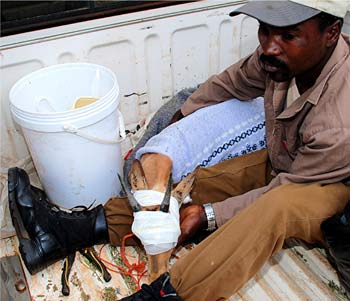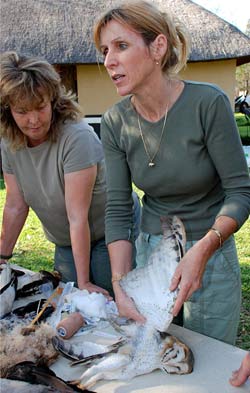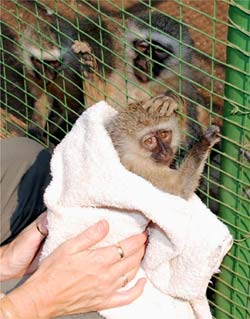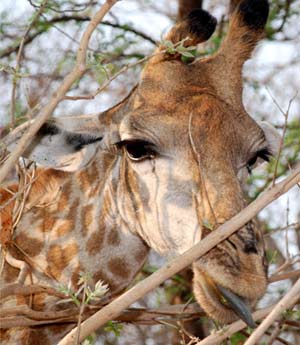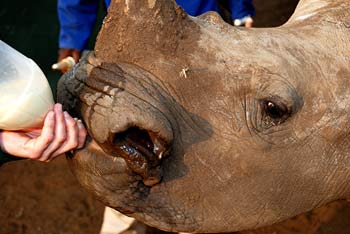The patient was already painfully weak when we found him wandering emaciated in the bush. Every effort was made: a drip set up, glucose rubbed into his gums and his frail body warmed with blankets and hot-water bottles. But he was too far gone. Eventually all that could be done was to keep him comfortable and calm, and watch as he slipped away.
The “patient” here was not human, but a young impala starving in the drought-stricken Limpopo bushveld, and taken to SanWild Wildlife Sanctuary and Rehabilitation Centre.
Yet this is how wildlife rehabilitators talk about the animals in their care: with gravity and the sincerest concern, no small measure of joy or sadness at the outcome, and as if the animals were human – or almost. “Rehabbers” don’t (except perhaps a couple of the flakier members of this often unconventional fraternity) mistake their charges for human, but they do give them a far higher status than is generally afforded other species by our own.
SanWild rehabber Zagaria Olifant holds the impala as it is transported to the centre. The eyes are bandaged to help keep the animal calm.
Bunnyhuggers in the cross-hairs
Wildlife rehabbers do get praise from some quarters, and often considerable media and public attention, but they also attract criticism and frequently the derisive label "bunnyhuggers" for their approach to animals.
“The rehabber’s focus,” says course instructor and veteran of this field, Karen Trendler, “is the individual animal”.
This one-on-one involvement, which takes dedication to understanding not only each separate species being treated, but each individual animal, is necessary for wildlife rehab to succeed – but is also where it comes into question: animals die harshly in the wild all the time; it’s Nature’s way. Isn’t it a sentimental, misguided impulse to try to save them, one by one?
Wildlife rehab centres rely heavily on funders who could be channeling that money into other – human – causes. In an increasingly resource-strapped world, can we really justify the considerable time, energy and expense involved?
Akin to alien abduction
Wildlife rehabilitation, the care and treatment of sick, injured or orphaned wild animals, ranges from that fledgling fallen from the nest you felt compelled as a child to “save” and feed with an eye-dropper, to the highly orchestrated disaster response required to rescue tens of thousands of sea birds during an oil spill.
In all cases though, the end-goal of a reputable rehab operation is releasing a healed, functional animal back into the wild. The ultimate indication of success, says Karen, is if a rehabilitated animal is able to breed. And if you ever went the fledgling eye-dropper route, you’ll know just how difficult that goal is to achieve.
These are wild animals, and being rescued and rehabbed for them is akin to one of us being abducted by aliens. The shock itself is enough to kill them – and often does. Some live, but are too compromised – physically or psychologically – to survive in the wild, and must find new careers as educational or companion animals. And many are too damaged for their suffering to be extended: anyone starry-eyed about getting into the rehab game needs to appreciate that euthanasia is a big aspect of the work.
It’s not enough to have a vague notion that you want to cuddle animals. You need a rare combination of empathy, patience and stoicism.
A high percentage of rehabbers (and wanna-be rehabbers, if the students on the course were an indication) are female, quite possibly because nurturing and caring impulses tend to be strong in women. But don't make the mistake of concluding this is a “soft” occupation for people seeking furry baby substitutes.
Rehabbing is hard, dirty work, physically taxing and emotionally stressful. Karen Trendler, who has been caring for animals for 25 years, is blond, gentle and physically slight. But she has climbed through electric fences to escape annoyed patients, been concussed by others, and has worked through many a sleepless night watching over the orphaned or ill.
Karen Trendler (right) lecturing on bird injuries, with SanWild owner Louise Joubert.
Another possible reason this field attracts women may be because we’re less concerned about being called soppy. I’ve found that in the still male-dominated and sometimes macho worlds of conservation, zoology and wildlife management, there is a persistent perception that feeling too much for animals is unscientific (and, by extension, unmasculine). Biologists live in horror of being accused of anthropomorphism.
But one can err on the opposite extreme: resolutely refusing to acknowledge the similarities between ourselves and the other creatures with whom we've evolved down the eons is not logical either.
Echoes of ourselves in other animals
Just as we share DNA with every other creature on the planet (we are all merely variations of the same four genetic building blocks), so we share much in terms of physiology and behaviour – especially with other vertebrates, the group rehabbers deal with primarily. A few of many examples cited by those working in the field:
- If a sick animal is going to “crash” and die, it will likely happen between 3am and 5am – as it does in human hospitals.
- Elephants under stress – in pain, or condemned to life in a circus – sway and pad their feet rhythmically – as distressed young human children often do.
- A baby vervet monkey brought to SanWild, likely bitten by a poacher's dog, whimpered with bad dreams in the night and was consoled by being held.
- Animals deprived of sufficient space, light and stimulation suffer many classic symptoms of "human" major depression: they lose interest in living, and refuse to eat or play or mate.
Introducing the young vervet undergoing treatment for dog-bite to other monkeys in the hope he will be assimilated and accompany them when they are released.
These echoes of human nature are also helpful in the rehabber's craft. Much of the knowledge about healing wild animals is gleaned and adapted from research on humans and domestic animals. Karen's approach with one patient, for example, a black rhino gored in the rectal area, was to call rape clinics for advice. Their suggestion, which proved effective, was not to interfere with the wound, but to spray the area with antibiotics and watch for infection.
But the differences among species are highly significant too. “We know this much about wildlife,” says Karen, making a tiny space between thumb and forefinger. Each kind of animal (and each patient) is unique, and each gets hurt and sick, and heals, in a unique manner.
Doctors attend to one species, most vets to a handful, but rehabbers and the specialised wildlife vets with whom they work must deal with whatever hapless wild creature ends up on their doorstop – which requires no small measure of ingenuity.
In one case where a local rhino had lost a foot, an elegant prosthesis was designed. The rhino succumbed to heart problems and fluid build-up from lack of movement, but the prosthesis design went overseas for use in similar cases, such as elephants who had lost feet to landmines.
When birds lose large feathers on their wings and tail, they are often rendered flightless. Rehabbers fit a feather shed from another bird onto the patient's broken-off feather shaft - with superglue and a piece of hypodermic needle inserted into the feather core. This might produce an odd-looking bird - a pale grey Ovambo sparrowhawk with a black crow's tail for example - but a bird that can fly while its own feathers hopefully re-grow.
Creative solutions must be employed during the release process as well. In one case, a PhD student acted as an alpha-male to direct the release of a baboon troop. His duties included putting insects in his mouth to encourage his followers (who were strangers to live food) to do the same.
Kariba, now a healthy adult, was handraised from a week old when her mother was caught in a snare. During her initial rescue, Kariba needed to be revived twice with CPR.
Fixing what we broke
In addition to addle-brained sentimentality, rehabbers also get accused of interfering in Nature. The weakness with this argument is that we have already interfered in nature – vastly, devastatingly, and possibly permanently. With very few exceptions, each poignant case in a rehab centre is a victim of that human interference.
As one species – ours – continues to go forth and multiply and use up more resources and space so we destroy more habitat, and bring the manifold dangers of the modern world to more wildlife. This is what we have wrought:
- Fractures, haemorrhages, concussions. Our ever-busier, ever expanding road networks lead to inevitable vehicle collisions.
- That icon of environmental devastation, the stranded and blackened sea-bird, swallowing toxins as it tries futilely to preen the oil from its body. Our lust for oil to drive those vehicles leads to marine spills and oiled sea birds, turtles, seals.
- A scorched nag-apie. A stunned owl with a wing wrenched from its socket, the feather-tips strangely curled. These are tell-tale signs of an electic current passing through the body. Our power lines cut across flightpaths, our electric fences slice up territories, causing broken limbs, burns and electrocutions.
- Cheetah cubs with splayed "ballet feet", barely able to stand properly, let alone sprint - the effect of dietary deficiency. We also impact on wild animals directly, where they are themselves the commodity. The South African wildlife industry has grown dramatically in the past few years, and Karen considers it “the most exploitative in the world”. Rehabbers are seeing more cases of inbreeding and poor nutrition, and a higher incidence of premature births from the stress of pregnant females being captured and improperly transported and penned.
The pet trade, both legal and illegal, produces yet more rehab patients. Baby vervets and baboons are cute, but after three to six months when they start to get territorial and aggressive, and develop dietary problems, their owners tire of them.
Dismally, animals can be hit by mutiple factors: a vulture, ill and disoriented from eating a poisoned carcass, collides with a car. A kudu is shot and, panicked, runs into an electric fence.
Even our young impala, who seems to have died a relatively “natural” death during a drought, may well be a victim of human-induced climate change.
The battle to save the planet is being fought on many fronts. Patching up maimed individual creatures – the end result of the ruinous processes we set in motion – is not preferable to stopping the processes themselves in the first place. But it's also not something, just because it's inconvenient and ethically complex, that we can turn away from.
We broke these animals. It’s surely our responsibility to fix them.
Feeding "Boytjie", an orphaned white rhino.
(- Olivia Rose-Innes, EnviroHealth Editor, Health24, updated April 2010)
Post a question or comment to the EnviroHealth Expert
Read more:
Animal sacrifice
Wildlife trade spurs disease
How to really save a whale




 Publications
Publications
 Partners
Partners



